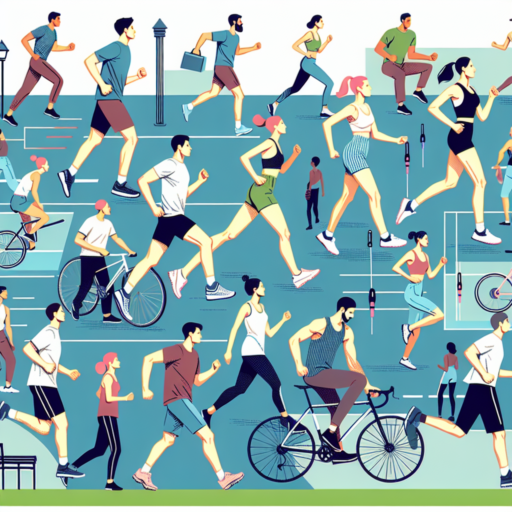What is Cadence Training and Why is it Important?
Cadence training refers to the focused effort on controlling and optimizing the rate at which an athlete performs their movements during physical activities, particularly in cycling and running. It involves the measurement and adjustment of steps or pedal strokes per minute to improve efficiency, speed, and endurance. This approach to training emphasizes the rhythm and tempo of exercise, aiming to find the optimal pace that an individual can maintain over time without quickly fatiguing.
The importance of cadence training lies in its potential to enhance athletic performance and reduce the risk of injury. By focusing on maintaining a consistent and efficient cadence, athletes can develop a smoother stride or pedal stroke, leading to more effective energy use during exercise. Additionally, adjusting one’s cadence can help in preventing overuse injuries commonly associated with imbalanced or inefficient movement patterns, as it encourages the muscles to work in a more coordinated and less straining manner.
Incorporating cadence training into your routine is crucial for those looking to elevate their performance levels and ensure long-term participation in their chosen sport. Whether you are a beginner aiming to establish a solid foundation or an advanced athlete looking to fine-tune your technique, understanding and applying the principles of cadence training can make a significant difference in your overall athletic ability.
The Benefits of Cadence Training for Runners and Cyclists
Cadence training is an essential component of a runner’s and cyclist’s training regimen, focusing on optimizing the number of steps or pedal strokes taken per minute. This approach not only enhances efficiency but also plays a crucial role in reducing the risk of injury. By maintaining a steady and optimal cadence, athletes can improve their performance significantly, making this aspect of training indispensable for those looking to excel in their disciplines.
Improves Efficiency and Performance
One of the most noteworthy benefits of cadence training is the substantial improvement in efficiency and overall performance. For runners, an increased cadence can lead to a more effective use of energy, as it encourages lighter foot strikes and minimizes ground contact time. Cyclists benefit similarly, as a higher cadence reduces muscle fatigue, allowing for a more consistent output over longer distances. By focusing on maintaining an optimal cadence, both runners and cyclists can extend their endurance and speed, pushing their limits farther than before.
Reduces Risk of Injury
Injury prevention is another significant advantage of cadence training. By emphasizing a quicker, more controlled pace, athletes are less likely to overstride or apply excessive force with each step or pedal stroke. This reduction in impact forces can lead to fewer injuries, specifically in areas vulnerable to overuse injuries such as the knees, hips, and back. Consequently, maintaining a consistent and optimal cadence not only enhances performance but also ensures athletes remain healthy and injury-free, enabling them to train consistently without forced breaks.
Ultimately, incorporating cadence training into a regular workout routine offers a multitude of benefits for runners and cyclists alike. From improving efficiency and performance to reducing the risk of injury, the importance of focusing on cadence cannot be overstated. As athletes strive to achieve their personal best, understanding and applying the principles of cadence training will undoubtedly play a pivotal role in their journey towards success.
How to Determine Your Ideal Cadence
Determining your ideal cadence is fundamental in maximizing efficiency and effectiveness in any endeavor, whether it’s running, cycling, writing, or beyond. Understanding and finding the right rhythm can significantly enhance performance by synchronizing your efforts with your body’s natural tendencies. This can lead to improved endurance, speed, and overall achievement.
Step 1: Assess Your Current Performance
Begin by evaluating your current cadence. For runners or cyclists, this means understanding your steps per minute or pedal strokes. Tools such as apps and wearable devices can offer precise measurements. Remember, the goal is to identify your starting point, not to judge its effectiveness. Knowing your baseline is crucial for making informed adjustments.
Step 2: Experiment With Adjustments
Once you’ve established your baseline, it’s time to experiment. Incrementally adjust your cadence and note any changes in comfort, speed, or endurance. This process requires attention and patience. For example, runners might aim to increase their steps per minute by a small margin and observe the outcomes. It’s vital to make gradual modifications to avoid injury and accurately gauge the impact on performance.
Identifying your ideal cadence is a personalized process that can significantly impact your efficiency and overall performance. By methodically assessing your current pace and experimenting with careful adjustments, you can discover a rhythm that enhances your capabilities and enjoyment of the activity.
Essential Cadence Training Workouts for Beginners
Embarking on a journey to enhance your running or cycling performance starts with understanding and improving your cadence. For beginners, cadence training is a pivotal element that can fundamentally transform your efficiency and endurance. This introduction to essential cadence training workouts is designed to help you grasp the basics and start improving your athletic performance effectively.
Understanding Cadence and Its Importance
Cadence, often measured in revolutions per minute (RPM) for cyclists and steps per minute (SPM) for runners, is crucial for optimizing your performance and preventing injuries. A higher cadence is typically associated with a more efficient and effective form, reducing the impact on your joints and musculature. By focusing on cadence training exercises, beginners can develop a stronger, more resilient stride or pedal stroke, setting a solid foundation for future training and achievements.
Basic Cadence Training Workouts
- Metronome Drills: Utilizing a metronome or a metronome app, set a target cadence and practice maintaining this rhythm throughout your workout. Start with a comfortable rate and gradually increase the beats per minute (BPM) as your comfort with the pace improves.
- Interval Training: Incorporate short bursts of high-cadence intervals into your regular training sessions. For cyclists, this could mean several minutes at a higher RPM than you’re accustomed to, followed by rest periods. Runners might focus on quickening their steps for short intervals, aiming to lightly touch the ground with each step.
- High-Cadence Workouts: Dedicate specific sessions to practicing and maintaining a higher cadence than your norm. For both runners and cyclists, these workouts help train your body to become more comfortable at a faster pace, improving your overall efficiency and performance.
Embarking on cadence training can seem daunting at first, but beginning with these fundamental workouts will pave the way to mastering your technique. By focusing on developing a higher, more efficient cadence, beginners can enjoy significant improvements in their performance, endurance, and injury resilience. Start incorporating these essential cadence training workouts into your routine to unlock your true athletic potential.
Advanced Cadence Training Techniques for Improved Performance
Perfecting your cycling technique involves focusing on various aspects, with cadence being one of the most critical. Advanced cadence training techniques are essential for cyclists looking to enhance their performance. Through specialized exercises and drills, cyclists can improve their efficiency, speed, and endurance on the bike. This approach emphasizes the importance of maintaining a steady and optimal cadence, which can significantly affect overall cycling performance.
Implement Interval Training for Cadence Improvement
Interval training is a powerful method to improve your cycling cadence. By alternating periods of high-intensity pedaling with lower-intensity periods, cyclists can gradually increase their leg speed and endurance. This type of training encourages the body to adapt to maintaining a higher cadence over extended periods, leading to improved performance during long rides or races. Focusing on short bursts of high cadence intervals, followed by periods of recovery, can help develop a cyclist’s ability to sustain higher speeds with greater efficiency.
Utilize Cadence Sensor Technology
Incorporating technology into your training regime can significantly impact your cadence improvement efforts. Cadence sensors, when paired with a cycling computer or smartphone app, provide real-time feedback on your pedaling speed. This immediate insight allows cyclists to adjust their cadence on the fly, ensuring they are always training at their optimal leg speed. By monitoring your cadence data over time, you can identify trends, set precise goals, and make informed adjustments to your training plan. Focusing on these metrics during different phases of your training can lead to noticeable improvements in your cycling performance.
Incorporating Cadence Training into Your Weekly Workout Routine
Adding cadence training to your weekly workout routine can significantly enhance both your performance and endurance. Cadence training, which focuses on improving the rate at which you perform an exercise—typically cycling or running—can help athletes and fitness enthusiasts alike to boost their efficiency and speed. Understanding how to effectively integrate this method can transform your workouts, making them more targeted and effective.
Cadence training emphasizes the importance of the rhythm and speed in your movements rather than just the distance covered or the intensity of the workout. For runners, this means increasing the number of steps taken per minute, while cyclists focus on pedal revolutions. This subtle shift in focus can lead to major improvements in muscular endurance and metabolic efficiency, reducing the risk of overuse injuries by promoting a more consistent, controlled effort during exercise.
To get started with cadence training, it’s crucial to first establish your baseline cadence. This involves tracking your current step or pedal rate during a steady, comfortable workout. Once you have this baseline, you can begin to incorporate cadence drills into your routine. For example, runners might include sessions focused on achieving a higher step rate for short intervals, while cyclists could work on maintaining a specific pedal revolution rate over a set distance or time. Gradual adjustments allow your body to adapt to the increased demands, making your regular training sessions more effective.
No se han encontrado productos.
Tools and Apps to Track and Improve Your Cadence
The quest for a better running or cycling performance often leads athletes to focus on their cadence. The right tools and apps can be game changers in tracking and improving this vital metric. With the technological advancements in fitness technology, several platforms now offer sophisticated features not just to monitor but also to enhance your cadency rhythm.
Top Cadence Tracking Devices
In the realm of cadence improvement, wearable technology stands out. Devices like Garmin and Wahoo utilize GPS and motion sensors to provide real-time feedback on your cadence. These gadgets are not only efficient in tracking but their feedback mechanism helps improve your strides or pedal strokes by identifying your optimal cadence range. Consistency in your rhythm can significantly impact your efficiency and reduce the risk of injury.
Essential Apps for Cadence Analysis
Next to wearable devices, mobile apps have taken center stage in providing comprehensive cadence analysis. Apps like Strava and Zwift integrate seamlessly with your wearable devices to offer a deeper insight into your performance. They help in setting cadence targets and track your progress over time. Moreover, they propose personalized workouts designed to enhance your cadence, making them indispensable tools for avid runners and cyclists alike. The Strava Summit approach, for example, breaks down your activities into granular metrics, letting you pinpoint where adjustments can yield the most significant improvements.
Common Mistakes to Avoid in Cadence Training
Engaging in cadence training is a pivotal approach for cyclists aiming to enhance their riding efficiency and performance. However, even the most diligent cyclists can inadvertently fall into certain traps that hinder their progress. By acknowledging and rectifying these common mistakes, cyclists can more effectively harness the benefits of cadence training.
Ignoring Your Body’s Signals
One crucial mistake many cyclists make is ignoring the body’s natural feedback during cadence training. It’s essential to listen to your body and adjust your training intensity accordingly. Pushing too hard without proper adaptation can lead to fatigue, injury, and ultimately, a setback in achieving your goals. Recognizing the difference between good pain, such as muscle soreness, and detrimental pain, signalling overuse or injury, is paramount for effective training.
Neglecting Lower Cadence Work
Another oversight is the neglect of lower cadence work. While high cadence training is beneficial for developing efficiency and reducing muscle fatigue, incorporating low cadence drills that focus on power and strength is equally important. These drills help in building muscle endurance and can significantly improve a cyclist’s overall performance. Balancing both high and low cadence work is a key aspect of a well-rounded cadence training program.
Avoiding these common mistakes in cadence training not only accelerates progress but also ensures a safer and more enjoyable cycling experience. By paying close attention to the body’s feedback and incorporating a mix of cadence intensities, cyclists can optimize their training and achieve their performance goals. Engaging in cadence training with mindfulness and strategy paves the way for substantial improvements in cycling efficiency and stamina.
Success Stories: How Cadence Training Changed My Running/Cycling
When it comes to enhancing athletic performance in running or cycling, cadence training stands out as a game-changer. Athletes from all around the globe have shared their transformative experiences, shedding light on how focusing on cadence refined their approach to these sports. This method, emphasizing the rhythm and pace of steps or pedal strokes, not only improves efficiency but significantly reduces the risk of injury. Let’s delve into some of the success stories that underscore the vitality of cadence training in running and cycling.
Many runners highlight the dramatic improvement in speed and endurance following the integration of cadence training into their routine. By adjusting their stride to a more optimal rate, they were able to cover longer distances without the usual fatigue. This shift not only uplifted their performance but also brought a newfound joy in the running experience, turning challenging marathons into more achievable feats. Similarly, cyclists reported a noticeable increase in their pedaling efficiency, attributing their success in strenuous races and uphill battles to the meticulous focus on maintaining a consistent cadence.
Another aspect underlined by these success stories is the significant reduction in injury episodes. Traditionally, the repetitive stress of running and cycling makes athletes prone to a spectrum of injuries. However, by adopting cadence training, individuals noticed a decrease in common issues like shin splints and knee pains. This prevention can be attributed to the more natural alignment and improved biomechanics encouraged by optimal cadence rates. It’s a testament to how minor adjustments in training methods can lead to major benefits in terms of health and performance.
Expert Tips for Maintaining Your Ideal Cadence in Long Races
Maintaining an ideal cadence throughout a long race is crucial for optimal performance and endurance. The cadence, or the number of steps a runner takes per minute, can significantly impact their speed, efficiency, and overall energy usage. Experts suggest that incorporating several strategies into your training can help stabilize your cadence and ensure you’re running at your best.
Understand Your Natural Cadence
Firstly, it’s essential to understand and identify your natural cadence. Use a running watch or a cadence sensor to track your steps per minute during different runs. Analyzing this data can provide insights into your natural rhythm and how it fluctuates under various conditions. By knowing your baseline, you can set realistic goals to improve or adjust your cadence as needed for longer distances.
Incorporate Cadence Drills into Your Training
Next, integrating specific cadence drills into your routine can significantly improve your ability to maintain an ideal pace. Drills such as high knees, butt kicks, and skipping exercises help develop the muscle memory and coordination needed for a consistent cadence. Practice these drills at least twice a week, focusing on maintaining a steady rhythm rather than speed. This emphasis on rhythm helps to instill a more consistent stride pattern during your long races.
Remember, maintaining your ideal cadence in long races is a dynamic process that requires ongoing attention and adjustment. Listen to your body, and be prepared to adapt your strategy based on how you feel during your training and races. With dedication and practice, you can develop the resilience and consistency needed to sustain your cadence and achieve your long-distance running goals.




